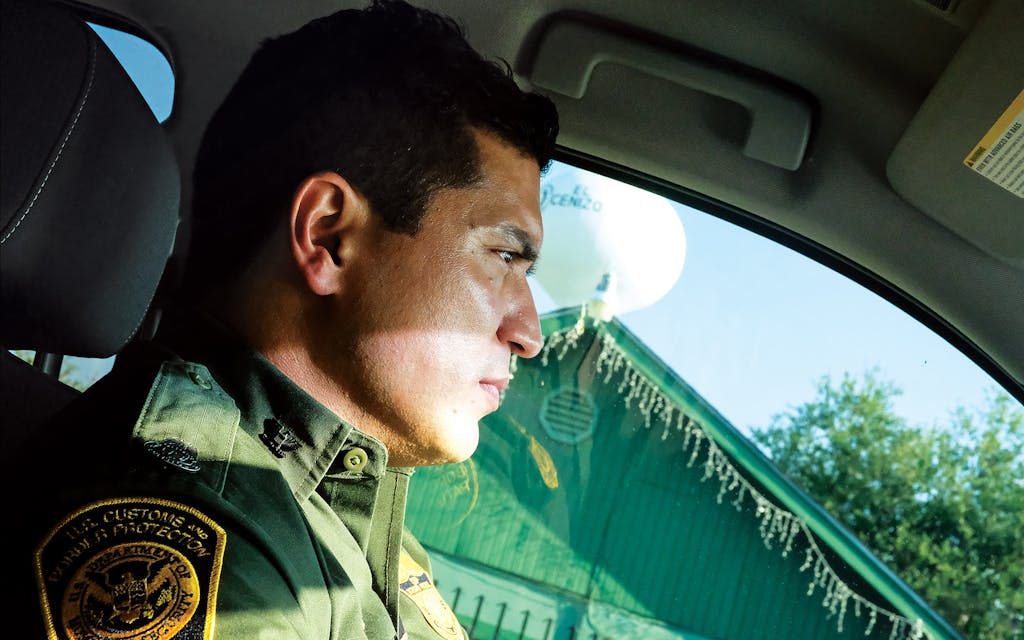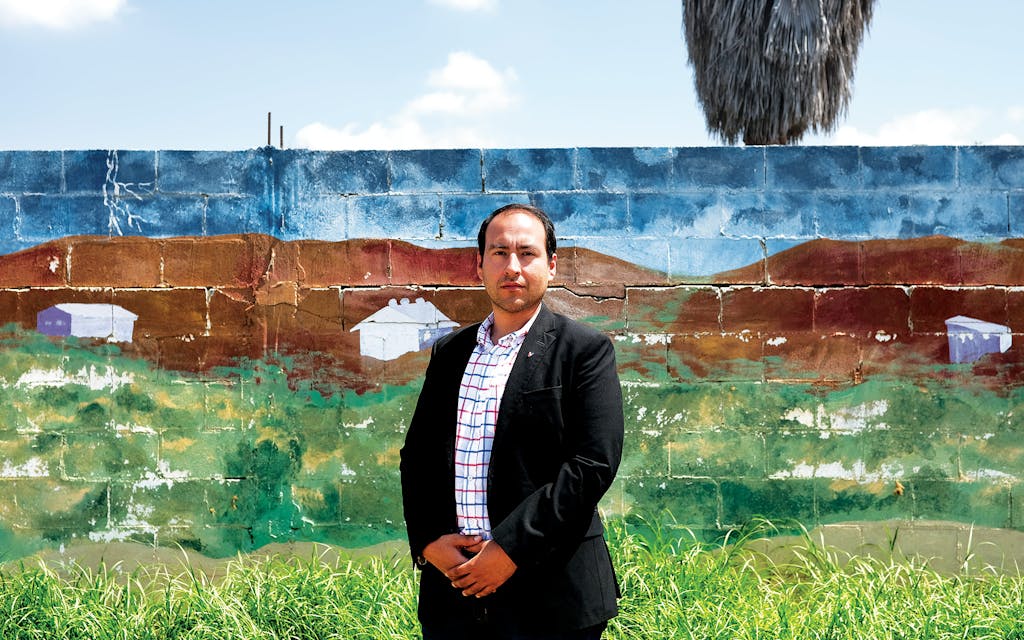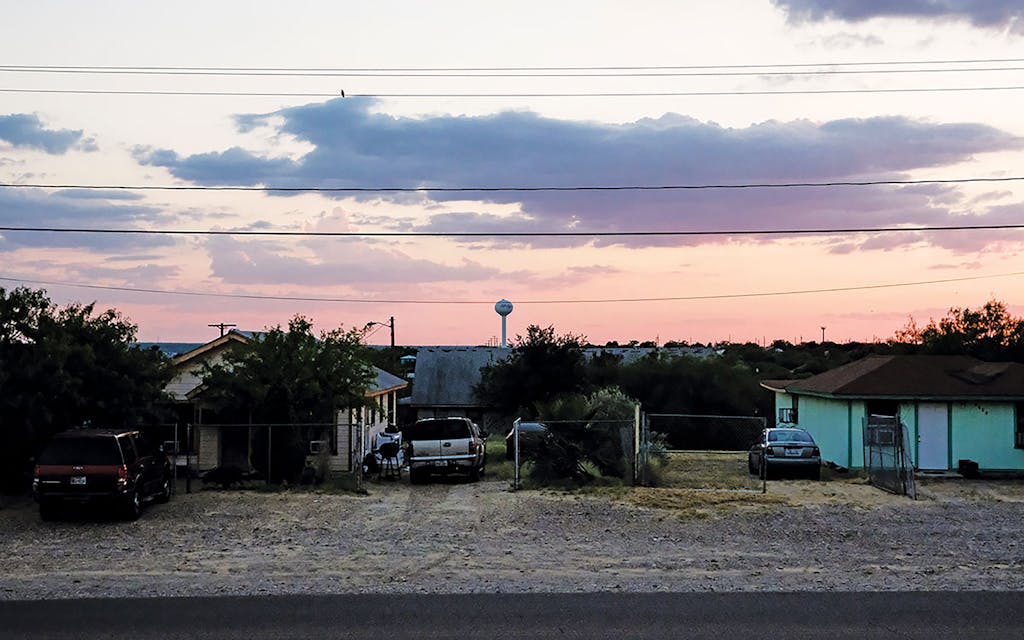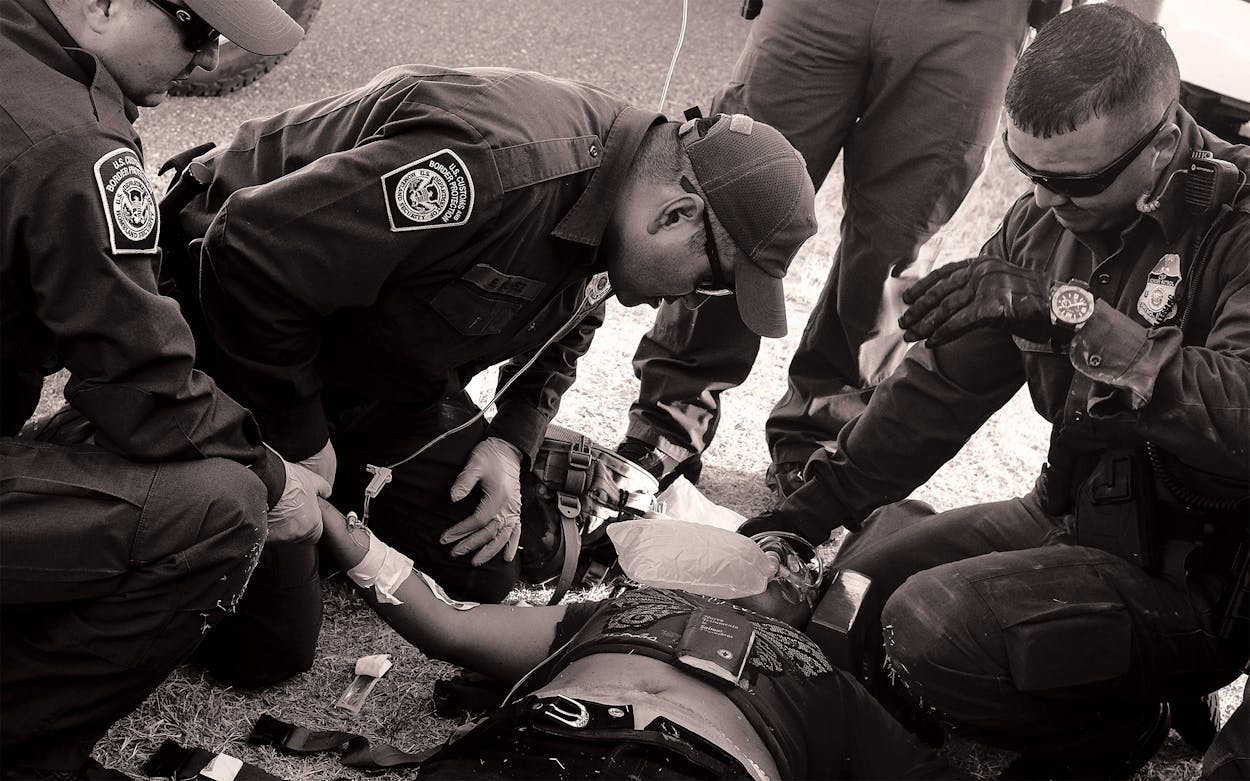It was late afternoon on a scorching June day in South Texas when the Border Patrol agents emerged from the brush with a woman lying limp in their arms. They set her down alongside Espejo Molina Road, the only street leading in or out of El Cenizo, a town just south of Laredo, less than a mile from the Rio Grande. She was barely conscious, and the agents called for backup. Another agent, Gabriel Acosta, was patrolling nearby when the call came over the radio, and he sped to the scene in his unmarked black SUV. Acosta, who is 41, is the assistant chief patrol agent of the Laredo Sector, where he helps oversee about two thousand agents. When Acosta arrived, the woman was in bad shape. She had left Guatemala two weeks earlier, he would later learn, traveling in the back of tractor-trailers and staying in stash houses. She had crossed into Texas on an inflatable raft earlier that day but had fainted not long after reaching American soil. Her smugglers had beaten her and left her for dead in the vast ranchland surrounding El Cenizo, where the barren landscape offered little protection from the sun and the 100-degree heat. She was severely dehydrated when the agent discovered her. And yet, Acosta had seen far worse. It’s not uncommon for agents to find bodies decomposing in the brush. This time they had the chance to save a life.
Half a dozen agents huddled around the woman lying on a stretcher by the road, frantically placing ice packs under her arms and pouring cool water over her feet and hands. They needed to bring her body temperature down, and they needed to do it quickly or her organs would fail. One agent inserted an IV and started dripping fluids. Another agent put an oxygen mask over the woman’s nose and mouth to keep her breathing. Brush clung to the sweat that caked the woman’s dirty skin, and her face was bloodied and bruised. Dehydration had induced delirium—her arms flailed and she wailed incoherently. When the woman calmed, an agent set a tattered copy of the Nuevo Testamento on her slowly heaving chest. It was all she had carried.
The agents had called an ambulance, but it was slow to arrive. Though El Cenizo has steadily grown and developed since its early days as an impoverished colonia, it remains too small and too poor to maintain a full-time ambulance service, and the nearest hospital is at least thirty minutes away, in Laredo. The Border Patrol is usually the first to respond to distress calls. Acosta said a big part of his job is protecting undocumented immigrants and the people of El Cenizo from being exploited by smugglers, who, once they’ve received payment, have little regard for the safety of their travelers—such as the Guatemalan woman. In El Cenizo’s unforgiving climate, arrest missions often turn into rescue operations. “To the alien-smuggling organizations, these human lives, they’re just a commodity,” Acosta said. “[But] that’s someone’s daughter, sister, mom, cousin.”

Scenes like this one, with Border Patrol agents pulling endangered immigrants from the brush, are a part of daily life here—as is the ever-present threat of deportation. The 3,200 or so residents of El Cenizo try to lead more or less normal lives amid a constant border struggle. Border Patrol agents scope out drug and human traffickers while handling the humanitarian crisis of migrants crossing the Rio Grande, all the while old men fish on the river, boys play soccer in a park nearby, and cowboys tend their horses in the high grass that grows by the water. Women carry groceries from the C&C Kountry Store, passing the small one-story homes that dot the city’s mostly sidewalk-less streets. In the evenings, pedestrians fend off stray dogs with sticks, fathers play catch with their sons in their driveways, and young girls cool off in kiddie pools. It’s the borderlands version of Anytown, USA.
But it’s also a place where residents feel the effects of immigration every day, and where strict deportation policies have real-life implications. It is where President Donald Trump’s promised border wall would run through the city’s backyard, and where many undocumented immigrants could be seized by emboldened Immigration and Customs Enforcement officers. (In the first few months of the Trump administration—between January 22 and April 29—ICE arrested more than 41,000 immigrants suspected of being undocumented, a 38 percent increase over the same span last year.) And it’s where Texas’s latest crackdown on illegal immigration could be felt most intensely.
In May, the Texas Legislature passed Senate Bill 4, which bans so-called sanctuary cities by requiring local governments to cooperate with federal immigration enforcement. It also includes what critics describe as a “show me your papers” provision, which allows law enforcement officers to inquire about the immigration status of people they detain. When Governor Greg Abbott took to Facebook Live to sign SB 4 into law, he said the legislation was necessary to keep Texans safe from criminals who shouldn’t be in the country and to enforce the rule of law. But opponents say it encourages racial profiling and will result in unnecessary deportations. They say it’s already stoked fear among immigrant communities all over Texas and especially in El Cenizo. After all, the town has been a declared sanctuary city since 1999, when it also made Spanish the official language of city meetings, a move a city commissioner at the time explained was more practical than anything else; many people in El Cenizo speak only Spanish (99 percent of its residents are Hispanic, many of them undocumented). And the town is once again taking a stand in the immigration debate.
Just days after SB 4 was passed, El Cenizo filed suit to block the law from taking effect. Civil rights groups, several Texas counties, and the state’s four biggest cities—Austin, Dallas, Houston, and San Antonio—have joined forces with El Cenizo in the suit while the Department of Justice has entered in defense of SB 4.
Between its brazen lawsuit, its city’s history of defiance, its high concentration of undocumented people, and the fluidity of the border on which it sits, perhaps no place in Texas better reveals the human drama behind the contentious immigration debate than this tiny town on the Rio Grande.
The man who signed up little El Cenizo to take on not only the state of Texas but also the Feds is the town’s youthful-looking 34-year-old mayor, Raul Reyes. As he sat at his desk in the town’s cramped sandy-colored city hall recently, Reyes wore a dark blazer over a checkered button-down shirt. He’s been mayor since he was 21. Now in his seventh term, he said his office is his favorite place to be in El Cenizo. His dark brown wooden desk was cluttered with papers and stuffed file folders. A stack of documents from the SB 4 lawsuit sat next to a pile of postcards from all over the state and country, some as far away as Anchorage, Alaska, from people supporting his immigration stance.
For now, the response to El Cenizo’s lawsuit against SB 4 has been mostly positive, he says, aside from some hateful emails and messages on social media. “I appreciate your courage,” wrote one person from Columbia, Missouri. “You make me proud to be an American,” wrote another, from Virginia.

His fight against SB 4 is a personal one. As he talked about the rise of toxic anti-immigrant rhetoric, including from his own state and federal governments, Reyes choked back tears. “I’m very disgusted by this law,” he said. “I’m very disgusted with the hate, with the anti-immigrant sentiment that we’re not only seeing now very heavily in Texas but across our country. . . . It’s very sad to see people look at you weird just because of the color of your skin.” He recalled when he recently took his mother, who has cancer, to San Antonio for radiation treatment. He felt that the white cancer patients looked at her funny and wouldn’t talk to her. “And that just broke my heart.”
Reyes has said he plans to leave office after his current term expires, in November 2018, but he told me that he’d consider changing his mind if it meant seeing the lawsuit all the way through, even to the U.S. Supreme Court.
He’s most concerned about the effect SB 4 will have on his people when they travel outside El Cenizo, particularly on their regular thirty-minute commute to Laredo, when they must pass through a stretch of highway patrolled by police departments in Laredo and neighboring Rio Bravo, the Webb County Sheriff’s Department, Texas state troopers, and the Border Patrol. “These are people that we go to school with, people that we share a meal with at one point, that we sit next to in church,” Reyes said of his constituents. “This is not the time to turn our backs on them and say you’re not welcome anymore, and we’re going to kick you out.”
The community has always been tight-knit. For years, there was no electricity or running water. The earliest residents had to wait for a water truck to arrive before they could shower or cook, and there was just one phone for the entire town. El Cenizo was incorporated in 1989, when it was still little more than a grid of unpaved roads lined by shacks and empty lots. Reyes was nine when he moved here with his mother, in 1992. He’d been born in Corpus Christi, but his great-grandparents lived across the border from El Cenizo, in Nuevo Laredo. His mother would often visit them. During one of her visits, Reyes’s mother noticed an advertisement in El Cenizo offering plots of land for a down payment of $100 and $50 a month. El Cenizo was still essentially a colonia then, but the land was cheap, and it was close to her grandparents. When Reyes first arrived, El Cenizo remained sparsely populated, but it was slowly starting to modernize.
By the time Reyes took office, in 2004, nearly all the streets had already been paved. Reyes’s administration has since finished that job, installed streetlights, and built a new park by the river, a new fire station, and a new library. Many residents work in construction or maintenance, but lately nurses and teachers have moved here to start families.
The growth was hardly painless. In 1999, city leaders passed the ordinance that made the town a safe haven for undocumented immigrants, making it a fireable offense for city employees (El Cenizo has only a few) to disclose anyone’s immigration status to federal authorities. And that same day the town decided it would hold its meetings in Spanish. News of the ordinances soon spread nationally. City hall received a steady flow of racist phone calls and death threats. One nationally syndicated radio host warned the people of El Cenizo to “get on their burros and go back to Mexico.” The Ku Klux Klan threatened to burn the city down.


Residents soon noticed an increased Border Patrol presence in the streets. Many El Cenizo residents began to feel that they were being profiled. There were more checkpoints along the highway around the time when El Cenizo’s commuters were returning from work in Laredo. Border Patrol agents frequently stopped and searched city buses, and they’d park in front of the elementary school as parents picked up and dropped off kids. It reached the point that, as the Associated Press reported at the time, there were “more Border Patrol agents than basketball hoops in the streets.” Reyes was in high school at the time, and he was already involved in city politics, attending each city hall meeting. “It seemed nobody could walk out on the streets without carrying proof of citizenship,” Reyes said. “We were even made fun of in school [in Laredo]. We were called every name in the books. That was the first of many challenges to come.” At the time, the Border Patrol denied that it was cracking down on the town, but it was clear that El Cenizo was being targeted. “When the mayor gets up and says on TV that [the majority of] the residents are illegals, you bet that got our attention,” a Border Patrol spokesman told USA Today in December 1999.
In the summer of 2000, tensions between the town and the Border Patrol reached a breaking point. People began to speak out about their experiences with the Border Patrol during city council meetings, inspiring some longtime El Cenizo residents to band together and form a group called Unidad y Firmeza por Nuestros Derechos Humanos, Unity and Strength for Our Human Rights. The group collaborated with Texas Rural Legal Aid, to help inform people in El Cenizo of their rights.
More people came forward with allegations of mistreatment at the hands of the Border Patrol. As the movement grew, the city formed a five-member Human Rights Commission to mediate with the Border Patrol, essentially acting as a civilian review board. Over the next two years, the commission compiled more than forty detailed complaints against the Border Patrol, including one incident in which a 44-year-old father and legal citizen was detained at gunpoint while delivering newspapers, prompting the federal Office of the Inspector General to investigate. In response to the formal complaints, Border Patrol leaders met with city officials and residents and pledged to improve their strained relationship with the community.
By most accounts, it did improve. So much so that now, nearly two decades later, Reyes said he’s not worried about how the Border Patrol will respond to stricter immigration policies. “They’re our partners, they’re our friends. We depend heavily on them to give us a sense of security. They do a lot of community outreach, and they take care of our people, regardless of who they are or where they come from,” the mayor said. Agent Acosta, meanwhile, downplayed concerns that SB 4 would lead to racial profiling from his agency. “You’re not going to stop somebody because they’re Hispanic,” he said. “When we stop to talk to someone, it’s for a reason. We’re not just going to go and just start talking to somebody just because they’re here in El Cenizo. It’s because some sort of illegal activity occurred, and that’s why we’re here.”
Ever since Trump promised during his presidential campaign last summer to deport 11 million people, perhaps the biggest fear among immigrant communities is that those who have well-established lives here would be rounded up in door-to-door raids and deported. Acosta said the Border Patrol won’t do that. “What you need to keep in mind is that we are looking for people who have just made illegal entry into the United States,” Acosta said. “We’re not looking for people who live in El Cenizo. We’re there to prevent the entry of and to apprehend anybody who has recently made entry. So we’re not going to be knocking on doors asking their immigration status. That is not our mission. That’s not why we’re in El Cenizo.”
But it’s the troubled history with the Border Patrol that forms the foundation of fear in El Cenizo over SB 4. Reyes said residents are already being asked to provide documentation when they’re stopped by state troopers or police in nearby Rio Bravo and Laredo, even though SB 4 doesn’t officially go into effect until September 1. The increased media attention from the lawsuit also has residents concerned that another retaliatory crackdown may be looming. And for Reyes, the danger is personal. If his lawsuit fails, he risks being removed from office, thanks to a provision in the law that allows the state to oust public officials if they continue to implement sanctuary policies.
Reyes, though, hasn’t let the prospect of losing his position deter him. “I’m not scared,” he said. “I refuse to back down and be intimidated by President Trump and the Department of Justice. I’ve said since the beginning, I will devote all of my passion, all of my energy and focus to this because I believe I’m doing the right thing, and I am on the right side of history. I owe it not only to the people who elect me to represent them but also to the millions out there who have no voice and live in fear.”


Many in El Cenizo do live in fear that they, or their relatives, will be detained and deported. Eighteen-year-old Manuel was in middle school when his mother was sent back to Mexico. It happened when his father was driving the family from El Cenizo to Laredo. They were pulled over by the Border Patrol, and the agents asked Manuel’s parents about their immigration status. His father had a green card, and Manuel was protected by Deferred Action for Childhood Arrivals, or DACA, the Obama administration’s program that shields kids who arrived in the country at a young age from deportation. But his mother was undocumented. “Then they took her,” Manuel said. (His name has been changed and some details omitted to protect his family’s identity.) With Manuel’s mother gone, his father had to quit his job to take care of Manuel and the other kids. Manuel was the one responsible for keeping his brothers and sisters calm. He told them their mother would be gone for a little while and assured them she’d be back, though he didn’t know for sure.
Manuel’s mother had carried him across the border when he was eleven months old, hoping he would get a good education and make a better life for himself than he could have in Nuevo Laredo. And he did. He became a straight-A student and will attend a prestigious university this fall—a major success story in a town that most boys rarely leave except to join the military. Manuel is different. He likes to fish and write love poems, and he plays the piano to relax—mostly Chopin or his favorite song, “River Flows in You,” by Yiruma, a needed respite from his draining school schedule. He would wake up every day at four in the morning to get ready for high school in Laredo, board the bus at 5:25, then stay late after class to study and participate in extracurricular activities, like robotics lab. On most nights, he wouldn’t return home until nine.
But all the while, there was a looming threat in the background that his family would be broken apart. After his mother was deported, she stayed in Mexico for a few months before his father sold their house in El Cenizo to pay smugglers to bring her across the border illegally for a second time. The family lived together in a rental in town, at least until Manuel went off to college in August. He wants to major in engineering and plans to go on to medical school so he can return to El Cenizo to open up a practice.
But his biggest fear is that he’ll have to return sooner than planned. With SB 4 scheduled to take effect just four days after Manuel is set to begin classes, he said he’s worried his mother will be deported again while he’s away at school. Should that happen, he’d likely have to leave college and come back to help his father raise his younger siblings. Still, Manuel tries to remain optimistic. “People in El Cenizo are worried, they’re scared,” he said. “They don’t really want to go out, because they’re scared of being deported. Me, personally, I don’t really worry about that. Why worry? If it’s gonna happen, it’s gonna happen. It’s better not to worry and just live happily and hope for the best.”
There are others in El Cenizo living under the threat of a state and federal crackdown on immigrants who are simply hoping for the best. “It’s a small town. Mostly all of us, we know each other, so we know who’s working legally and illegally,” said Fernando Lopez while cleaning a yard that sits a block from the Rio Grande. Lopez, who is 27, has been living here legally since 1996; he works for his father’s landscaping company. “We just want to pay our bills, go to work, and live our life,” he said. “If you’re working illegally and paying your bills and feeding your kids, hey, that’s not my problem. I got three kids—eight, seven, and a baby. I got mouths to feed. I go every single day to work. Cops see me, Border Patrol see me, and they know I’m not doing nothing bad. Let’s just hope it stays the same.”
SB 4 had its first hearing, in a San Antonio federal court, in June. More than one hundred protesters arrived by bus and gathered outside the courthouse in the 93-degree heat, chanting, “Hey hey, ho ho, SB 4 has got to go,” and holding signs that said “SB 4 Is Hate.” Inside a court room packed with reporters, Reyes watched as lawyers for the American Civil Liberties Union, arguing on El Cenizo’s behalf, contended that the new state law illegally targets Latinos and asked the judge to issue an injunction, barring SB 4 from going into effect on September 1.
The plaintiffs’ lawyers claimed the law would effectively force law enforcement officers to question minorities about their immigration status, because of harsh penalties they could face if they don’t follow SB 4. Texas senator José Rodriguez, a Democrat from El Paso, arrived at the courthouse more than two hours early. “This is the most important lawsuit in the state and the country at this time,” Rodriguez told the Texas Observer. “It’s anti-immigrant, racist, discriminates against Latinos.” When state representative Ana Hernandez, a Houston Democrat, testified for El Cenizo’s side, she broke down on the stand as she recalled her childhood as an undocumented immigrant. One attorney for the plaintiffs called SB 4, particularly the show-me-your-papers provision, a “constitutional train wreck,” according to the Washington Post.

The state, meanwhile, did not call any witnesses. Its attorneys repeatedly argued that the law does not encourage racially biased policing. “There’s no racial focus in Senate Bill 4” said Brantley Starr, a lawyer with the Texas attorney general’s office, according to the San Antonio Current. Starr’s co-counsel Darren McCarty called SB 4 a modest law that was needed to address inconsistencies throughout the state regarding immigration enforcement policies. The hearing lasted the entire day and ended without a decision. At press time, U.S. district judge Orlando Garcia had yet to issue a ruling.
The day after the hearing, agent Acosta called the hospital in Laredo. He’d been wondering what had happened to the Guatemalan woman who was pulled from the brush. It had been days since Acosta had helped rescue her on Espejo Molina Road, and her fate still weighed heavily on his mind. When the hospital returned his call, the news wasn’t good. She’d arrived in critical condition, and her prognosis had deteriorated in the days since. Her family in Guatemala was considering removing her from life support. It seemed likely she would die.
But in the days that followed, she miraculously began breathing on her own, though she was still in a coma. If she recovers, she’ll likely face deportation. But for the moment, here she remained, caught between borders, and between life and death.
This article originally appeared in the September 2017 issue of Texas Monthly.
- More About:
- Politics & Policy
- Texas Legislature
- Longreads
- Border Patrol







